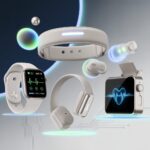
Wellness Tech 2.0: Sophisticated Solutions, High-Level Insights, and the Next Frontier of Innovation
The wellness industry has entered a bold new chapter—one that blends neuroscience, physics, biofeedback, and artificial intelligence to offer sophisticated solutions for the body, brain, and beyond.
No longer confined to simple fitness tracking or generic advice, wellness tech is now tackling the deeper, more complex layers of human optimization.
In this post, we explore the high-level insights and next-frontier innovations that are redefining what’s possible in personal well-being.
From neural feedback headsets that rewire thought patterns to quantum healing devices that aim to realign cellular energy, we’re venturing beyond the basics into the future of health.
Let’s unpack the advanced tools and concepts at the cutting edge of human wellness.
Sophisticated Solutions: Going Beyond Traditional Biohacking
While basic wearables still dominate the market, the real innovation is happening in tools that interact with your biology in more nuanced and direct ways.
These solutions do more than track—they intervene, correct, and optimize in real time.
1. Neurofeedback Headsets
Tools like NeurOptimal, Muse S, and Sens.ai use EEG sensors to detect brainwave patterns and guide users into optimal states of focus, calm, or creativity.
Unlike meditation apps, these headsets respond dynamically to your cognitive state, offering feedback through sound or light to promote neural flexibility and improved mental performance.
2. Red and Near-Infrared Light Therapy (Photobiomodulation)
Devices such as Joovv, Luminance RED, and PlatinumLED Bio Series harness red and NIR wavelengths to boost mitochondrial function, reduce inflammation, and support skin regeneration.
These treatments, backed by clinical studies, are being used for muscle recovery, hormone regulation, and even mood enhancement.
3. Wearable PEMF Devices
Pulsed Electromagnetic Field (PEMF) technology, featured in wearables like BEMER, OmniPEMF NeoRhythm, and Sentient Element, applies low-frequency magnetic waves to stimulate cellular repair and circulation.
These tools are favored by athletes and chronic pain sufferers for recovery and energy balance.
These are not gimmicks—they’re the sophisticated successors to step counters and sleep trackers, offering interaction at the cellular and neural level.
High-Level Insights: What the Data is Revealing
As wellness tech becomes more precise and integrated, it’s yielding valuable insights that change how we view health and performance. Here are three that stand out:
Insight #1: The Brain and Gut Must Be Trained Together
Next-gen platforms are confirming what ancient wisdom has suggested for years: the brain and gut are tightly linked.
Platforms like Viome and DayTwo are using microbiome testing to generate cognitive performance plans, showing that specific bacterial strains influence mental clarity, mood, and focus.
Insight #2: Sleep Isn’t Recovery—Depth of Sleep Is
Data from platforms like Eight Sleep and Whoop reveal that recovery isn’t just about duration.
It’s about reaching deep sleep consistently, especially after physical or emotional stress.
Tech that can measure and enhance sleep architecture—like adjusting bed temperature or breathing rhythms—has a measurable impact on performance.
Insight #3: HRV is More than a Fitness Metric—It’s a Life Metric
Heart Rate Variability (HRV) has evolved into a core marker of systemic health.
Longitudinal HRV tracking is now being used to anticipate burnout, immune suppression, and even emotional overload—offering the first early warning system for lifestyle correction.
These insights represent a new dimension of wellness: personalized, predictive, and preemptive.
Next-Frontier Innovations: Where Wellness is Headed
As we move beyond even the most advanced wearables and apps, a new class of innovation is emerging—one that blends biology with quantum physics, energy medicine, and AI-driven health modeling. Here’s a look at what’s next.
1. Quantum Healing Devices
Devices like the Healy Resonance and TimeWaver claim to use quantum frequency analysis to detect and influence energy imbalances at the bioenergetic level.
While the science is still debated, anecdotal evidence suggests benefits for mood, energy, and recovery.
These tools scan for vibrational discord and transmit frequency “programs” to re-balance your field.
2. Full-Spectrum Frequency Medicine
Companies are exploring the effects of binaural beats, Schumann resonance, and solfeggio frequencies delivered through wearables and soundscapes.
The idea is to use subtle vibrational patterns to tune brain states and even stimulate healing at the tissue level.
This innovation is a direct challenge to traditional pharmacology, proposing a model of vibrational medicine that interacts with biology through resonance, not molecules.
3. AI-Powered Health Twins
Startups are now developing virtual “health twins”—AI-generated simulations of your body based on DNA, lab results, and biometric data.
These avatars are used to simulate responses to different diets, training protocols, or supplements before you try them—reducing trial and error in personal health decisions.
This is the future of predictive health: running simulations on yourself before making real-world changes.
Integrating the Sophisticated with the Practical
While these innovations may sound advanced, many of them are already available—and accessible—for daily use.
Here’s how to bring high-level wellness into your current routine:
-
Start With Precision: Use wearable data to establish baselines. Then, introduce one intervention at a time—like red light therapy or neurofeedback—and measure changes in sleep, HRV, or mood.
-
Stack Bioenergetic Tools: Combine PEMF with guided breathwork or HRV coherence sessions for exponential recovery. Use frequency-based apps during meditation or journaling to deepen impact.
-
Run Micro-Experiments: Try a 14-day protocol with a quantum or neuroadaptive device. Track physical, emotional, and cognitive changes daily. This builds awareness and clarity on what actually moves the needle.
-
Leverage AI Support: Use apps like InsideTracker, Gyroscope, or CarePredict to analyze your biometrics and get daily adjustments to lifestyle factors—bringing elite-level insight into your everyday life.
Closing Thought: We’re Just Getting Started
Wellness technology is no longer a side tool—it’s becoming a central operating system for modern life.
And as sophisticated solutions, high-level insights, and next-frontier innovations continue to evolve, the way we define “health” will shift from reactive to responsive, from generic to precision-tuned.
We’re not just optimizing habits anymore—we’re upgrading human potential.
If you’re ready to move past surface-level tracking and explore what’s possible at the edge of health, now is the time to lean in. The tools are here. The data is rich.
And the frontier? It’s just opening up.











